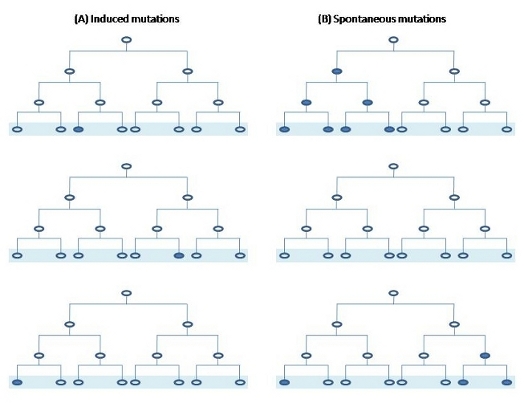MUTATE: IN SILICO PERFORMANCE OF THE FLUCTUATION TEST

Hints
- After download Mutate requires the Java 5.0 (or higher) Runtime Environment freely available at http://www.java.com.
- Whatever the operating system, you should be able to run the program just by double clicking on the mutate.jar file
- WINDOWS USERS: If double-clicking the .jar file does not open the program, make sure that the jar extension is associated with javaw.exe (in your JRE folder).
Contact
For any questions you can contact me
Return to AC-R home
Introduction
Mutate (Carvajal-Rodríguez 2012. Biochemistry and Molecular Biology Education [see article]) is a program for the emulation of the so called fluctuation test (Luria and Delbruk 1943). It is developed to
teach a virtual laboratory class for intermediate-level undergraduate students in Biology.
The key idea is to train students in some multidisciplinary aspects of current genetics as sequence databases, DNA mutations and hypothesis
testing, while introducing the fluctuation test.
During the practice the students should download some sequences, e.g the fhuA gene responsible for membrane receptor of phage T1 in E. coli,
introduce some stop codon mutations and design a fluctuation test, using adequate parameter values for the number of bacteria,
the number of plates, the mutation rate and the number of experimental replicates, to obtain data for distinguishing between preadaptative (spontaneous)
and direct (induced) mutation hypotheses.

It is worthmentioning the fundamental importance of the Luria and Delbruck's experiment and analysis that opened the way of modern bacterial genetics that 25 years later advocated in the beginning of the recombinant DNA era (see Robert Robbins 2001 introduction on the electronic reediting of 1943 original Luria and Delbruck's paper available via the Electronic Scholarly Publishing group). Additionally, Luria and Delbruck not only solved the dilemma of genetic mutation in bacteria, they also provided estimation for the mutation rate in bacteria for the first time.
A. Carvajal-Rodriguez - Departamento de Bioquímica Genética e Inmunología - Universidad de Vigo.
( Last update: February 2023)